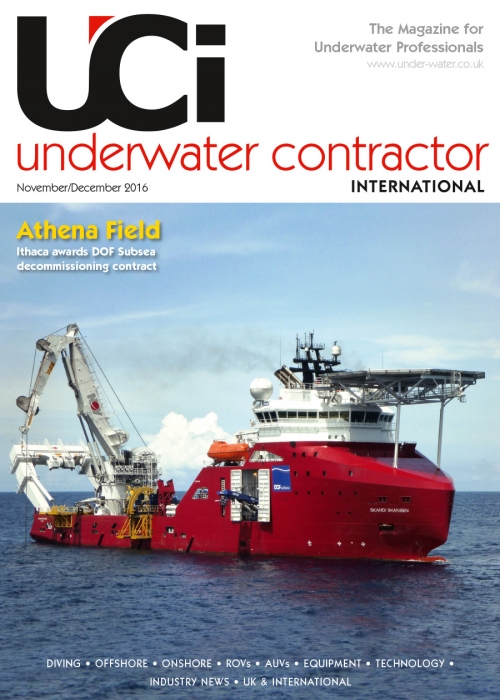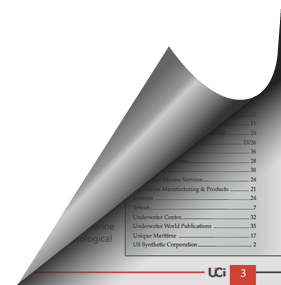
The Magazine for Underwater Professionals
![]() Jan/Feb 2015
Jan/Feb 2015
INDUSTRY NEWS - EQUIPMENT & TECHNOLOGY
Ennsub unveils new deepwater ROV launch and recovery systems
Ennsub, UK, reports it has completed the design and manufacture of two innovative work-class ROV deployment systems which have been designed and manufactured for ROVOP, UK, and are due to be installed into the newbuild, tier one pipelay vessel Ceona Amazon early in 2015.
The company said that a number of senior figures from the oil and gas industry were given an insight into Ennsub’s DEEP 4000 system recently before visiting its new Teesside premises.
“The demonstration showed the equipment’s capabilities, which includes a unique cable handling solution designed to maximise umbilical lifespan, particularly in ultra-deepwater and other high-fatigue applications such as active heave compensation,” said Ennsub. “The system also has a high-speed electric winch with full active-heave compensation, semi-dipping extendable A-frame and transfer skidding system for large tool packages. A new control system and human machine interface provides the client with a fully integrated and centralised operating station.”
Ennsub added that its integrated ROV launch and recovery solutions offer a next generation approach to ROV deployment, particularly in supporting top-tier subsea construction assets where reliability and performance are required.
UK-based Tritex NDT has announced the introduction of the Mark 2 Multigauge 3000 underwater thickness gauge.
The company said the system uses multiple echo to completely ignore coatings up to 20 millimetres thick, so that only the metal thickness is measured.
“All measurements are error checked to ensure only accurate readings are displayed, even on uncoated metal. The gauge is simple to use, with little operator input, and has a large bright 10-millimetre display which ensures it can be easily read by the diver, even in poor visibility,” the firm added.
Bowtech Products, headquartered in Aberdeen, UK, has announced the release of the Pioneer multipurpose underwater camera with LEDs.
The Pioneer is a high-resolution underwater colour CCD camera with six integral high intensity LEDs. It provides a cost effective solution to general underwater viewing observation, down to 4000 metres ocean depth, according to Bowtech.
The Pioneer is also available as a monochrome version
Phoenix, USA, has completed an upgrade of the US Navy’s 8000-foot (2400-metre) depth capable ROV Deep Drone. All work was performed under a multi-year contract with the US Navy’s Office of Supervisor of Salvage and Diving. The upgrade included installing a new umbilical, sonar, high-definition camera, LED lighting system, an updated frame and a new foam pack. In addition, and at the heart of the upgrade, Phoenix installed a completely new Programmable Logic Controller (PLC)-based vehicle control system.
“This new PLC-based control system was designed to increase the vehicle’s bandwidth to accommodate advanced sensors and provide intuitive, accessible functionality to allow ROV technicians to address common software related challenges. To support the greater demand for bandwidth, the overall system design also included fibre optics throughout the vehicle and within the vehicle’s new umbilical,” said Phoenix.
Additional advantages of the PLC-based control system design include improved maintainability and reliability due to commercial off-the-shelf components and software that are readily available and supported worldwide, the company said. Incorporated into the PLC-based control system was an extensive graphical user interface (GUI) for both control and diagnostics with GUI screens, it added.
Kongsberg Maritime, Norway, has launched an all-new high-resolution monochrome CCD camera. The OE15-100D camera is smaller yet has a deeper rated housing and wider angle of view (AOV) in water than any of its predecessors, whilst maintaining Kongsberg’s exceptionally high standard of build and image quality, said a spokesman.
With near SIT (Silicon Intensifier Target) performance in low light level conditions, an exceptionally wide AOV (102 degrees in water) and a water corrected optical arrangement that minimises distortions and aberrations, the OE15-100D is ideally suited to mid-water navigation tasks, general observation and situational awareness, as well as tether monitoring applications, the spokesman added.
The new camera’s titanium alloy housing is depth rated to 4500 metres.
MMT Sweden and Reach Subsea, Norway, have jointly invested in developing a new underwater tool for seabed mapping and pipeline inspection with the Norwegian ROV manufacturer Kystdesign.
The new ROV, called Surveyor Interceptor, has the innovative shape, powerful propulsion and advanced instrumentation to perform work four to eight times faster than existing work-class ROVs, according to the companies. The umbilical and handling system yields up to six times better endurance than autonomous underwater vehicles and the automatic tracking and station holding system delivers unsurpassed stability, they said.
“This machine has a punch I could never have dreamt of. With the high precision instruments, we can map at a quality not ever achieved before at a reasonable cost,” said Ola Oskarsson, founder of MMT Sweden.
“I am very pleased with the team and the effort resulting in this fantastic machine. We are looking forward to presenting this extreme surveyor to the market,” said Jostein Alendal, CEO of Reach Subsea.
CARRY
The ROV is designed to carry survey instrumentation to perform pipeline inspection, route surveys, subsea installation surveys and environmental surveys down to 2000 metres water depth.
Great emphasis is put to high-resolution and accuracy. To achieve this the ROV is equipped with an onboard inverted USBL from Sonardyne, UK, doubled by normal Kongsberg, Norway, HiPAP transponders. This will increase accuracy and ensure redundancy. Also, the positioning is supported by two INS systems and a DVL. The test of station holding, line running and tracking have given outstanding results, MMT and Reach said.
The companies said that the ROV propulsion has allowed speeds of well over six knots to be reached with auxiliary power intact, and added that, following sea trials, the driveline will be adjusted to ensure stability and power management up to eight knots. “We believe this is a world record for a ROV,” they said.
SPEED
The multibeam system delivers 40Hz ping up to 20 metres above seafloor. This, together with the 800 beams, ensures dense point coverage, even at high speed. To improve top of pipe accuracy and ovality measurements, a 25Hz triangulating laser system from Cathx Ocean, Ireland, covers the central five metres of the survey corridor delivering millimetre accuracy measurements.
Three photomosaicing cameras are synchronised with powerful strobe lights, taking 3D, stereo and geo-corrected photos of the pipe to produce high-resolution GIS data of pipe status and possible third party intervention.
SeeByte, UK, reports it has successfully demonstrated its Automatic Target Recognition (ATR) software using a L-3 Klein Associates, USA, sonar payload (L-3 Klein UUV-3500, dual frequency 455/900 kHz) on an Iver3 autonomous underwater vehicle.
The process involved the ATR software being tuned to the Klein sonar in order for the software to be able to identify contacts of interest in the sonar data. The tuning of the sonar was done using settings commonly applied in mine countermeasures (MCM) missions. Once the mission was completed the data was imported into SeeTrack Military where the Mission Review tool was used to mark and measure contacts. The geo-referencing engine was used to visualise all relevant data from that same location.
Frank Cobis, vice president and general manager at L-3 Klein, said: “We are looking forward to offering this advanced capability to our customers. Using the Klein UUV-3500 sonar with the ATR module will allow our customers to effectively collect larger quantities of data and automatically process and identify contacts. This is a huge step forward for the MCM community using our sidescan sonar.”


